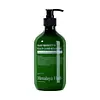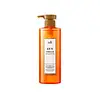What's inside
What's inside
 Key Ingredients
Key Ingredients

 Benefits
Benefits

 Concerns
Concerns

 Ingredients Side-by-side
Ingredients Side-by-side

Water
Skin ConditioningCoco-Betaine
CleansingSodium Cocoyl Alaninate
Lauryl Glucoside
CleansingDisodium Laureth Sulfosuccinate
CleansingGlycerin
HumectantSodium Chloride
MaskingSodium Lauroyl Methyl Isethionate
CleansingCaprylyl Glycol
EmollientCetyl Alcohol
EmollientHydroxyacetophenone
AntioxidantPolyquaternium-10
Menthol
MaskingGuar Hydroxypropyltrimonium Chloride
Skin ConditioningCitric Acid
BufferingMelaleuca Alternifolia Leaf Oil
AntioxidantPentasodium Pentetate
Citrus Paradisi Peel Oil
MaskingNardostachys Jatamansi Rhizome/Root Extract
Skin ConditioningButylene Glycol
HumectantPanthenol
Skin ConditioningCentella Asiatica Extract
Cleansing1,2-Hexanediol
Skin ConditioningSimmondsia Chinensis Seed Oil
EmollientArgania Spinosa Kernel Oil
EmollientCamellia Sinensis Leaf Extract
AntimicrobialHydrogenated Lecithin
EmulsifyingRosmarinus Officinalis Leaf Extract
AntimicrobialMelaleuca Alternifolia Leaf Extract
PerfumingSalvia Officinalis Leaf Extract
CleansingCamellia Japonica Flower Extract
EmollientEthylhexylglycerin
Skin ConditioningCeramide NP
Skin ConditioningLavandula Angustifolia Flower Extract
CleansingHistidine
HumectantProline
Skin ConditioningPhenylalanine
MaskingTryptophan
MaskingThreonine
Tyrosine
MaskingTaurine
BufferingOrnithine
Skin ConditioningArginine
MaskingAlanine
MaskingIsoleucine
Skin ConditioningAspartic Acid
MaskingAsparagine
MaskingCystine
MaskingMentha Viridis Extract
MaskingSerine
MaskingValine
MaskingMethionine
Skin ConditioningLeucine
Skin ConditioningLysine
Skin ConditioningGlutamine
Skin ConditioningGlutamic Acid
HumectantGlycine
BufferingCalendula Officinalis Flower Extract
MaskingMelissa Officinalis Leaf Extract
Skin ConditioningSodium Hyaluronate
HumectantHydrolyzed Hyaluronic Acid
HumectantHydroxypropyltrimonium Hyaluronate
Pentylene Glycol
Skin ConditioningSodium Hyaluronate Crosspolymer
HumectantSodium Acetylated Hyaluronate
HumectantArtemisia Vulgaris Extract
Skin ConditioningWater, Coco-Betaine, Sodium Cocoyl Alaninate, Lauryl Glucoside, Disodium Laureth Sulfosuccinate, Glycerin, Sodium Chloride, Sodium Lauroyl Methyl Isethionate, Caprylyl Glycol, Cetyl Alcohol, Hydroxyacetophenone, Polyquaternium-10, Menthol, Guar Hydroxypropyltrimonium Chloride, Citric Acid, Melaleuca Alternifolia Leaf Oil, Pentasodium Pentetate, Citrus Paradisi Peel Oil, Nardostachys Jatamansi Rhizome/Root Extract, Butylene Glycol, Panthenol, Centella Asiatica Extract, 1,2-Hexanediol, Simmondsia Chinensis Seed Oil, Argania Spinosa Kernel Oil, Camellia Sinensis Leaf Extract, Hydrogenated Lecithin, Rosmarinus Officinalis Leaf Extract, Melaleuca Alternifolia Leaf Extract, Salvia Officinalis Leaf Extract, Camellia Japonica Flower Extract, Ethylhexylglycerin, Ceramide NP, Lavandula Angustifolia Flower Extract, Histidine, Proline, Phenylalanine, Tryptophan, Threonine, Tyrosine, Taurine, Ornithine, Arginine, Alanine, Isoleucine, Aspartic Acid, Asparagine, Cystine, Mentha Viridis Extract, Serine, Valine, Methionine, Leucine, Lysine, Glutamine, Glutamic Acid, Glycine, Calendula Officinalis Flower Extract, Melissa Officinalis Leaf Extract, Sodium Hyaluronate, Hydrolyzed Hyaluronic Acid, Hydroxypropyltrimonium Hyaluronate, Pentylene Glycol, Sodium Hyaluronate Crosspolymer, Sodium Acetylated Hyaluronate, Artemisia Vulgaris Extract
Water
Skin ConditioningSodium C14-16 Olefin Sulfonate
CleansingCocamidopropyl Betaine
CleansingGlycerin
HumectantPyrus Malus Fruit Extract
Skin ConditioningVinegar
Decyl Glucoside
CleansingVitis Vinifera Fruit Extract
Skin ConditioningRoyal Jelly Extract
Skin ConditioningPersea Gratissima Fruit Extract
EmollientHippophae Rhamnoides Fruit Extract
Skin ConditioningSaccharum Officinarum Extract
MoisturisingMelaleuca Alternifolia Leaf Extract
PerfumingOlea Europaea Fruit Extract
BleachingDaucus Carota Sativa Root Extract
Skin ConditioningPrunus Mume Fruit Extract
HumectantRubus Chamaemorus Fruit Extract
AntioxidantHibiscus Sabdariffa Flower Extract
Skin ConditioningLuffa Cylindrica Fruit Extract
Skin ConditioningActinidia Chinensis Fruit Extract
EmollientCitrus Limon Fruit Extract
MaskingAdansonia Digitata Seed Extract
Skin Conditioning1,2-Hexanediol
Skin ConditioningCaprylhydroxamic Acid
Ethylhexylglycerin
Skin ConditioningMethylpropanediol
SolventSodium Chloride
MaskingPolyquaternium-10
Allantoin
Skin ConditioningGuar Hydroxypropyltrimonium Chloride
Skin ConditioningDisodium EDTA
Cocamide Mea
EmulsifyingCynanchum Atratum Extract
Skin ConditioningCitric Acid
BufferingParfum
MaskingWater, Sodium C14-16 Olefin Sulfonate, Cocamidopropyl Betaine, Glycerin, Pyrus Malus Fruit Extract, Vinegar, Decyl Glucoside, Vitis Vinifera Fruit Extract, Royal Jelly Extract, Persea Gratissima Fruit Extract, Hippophae Rhamnoides Fruit Extract, Saccharum Officinarum Extract, Melaleuca Alternifolia Leaf Extract, Olea Europaea Fruit Extract, Daucus Carota Sativa Root Extract, Prunus Mume Fruit Extract, Rubus Chamaemorus Fruit Extract, Hibiscus Sabdariffa Flower Extract, Luffa Cylindrica Fruit Extract, Actinidia Chinensis Fruit Extract, Citrus Limon Fruit Extract, Adansonia Digitata Seed Extract, 1,2-Hexanediol, Caprylhydroxamic Acid, Ethylhexylglycerin, Methylpropanediol, Sodium Chloride, Polyquaternium-10, Allantoin, Guar Hydroxypropyltrimonium Chloride, Disodium EDTA, Cocamide Mea, Cynanchum Atratum Extract, Citric Acid, Parfum
Ingredients Explained
These ingredients are found in both products.
Ingredients higher up in an ingredient list are typically present in a larger amount.
1,2-Hexanediol is a synthetic liquid and another multi-functional powerhouse.
It is a:
- Humectant, drawing moisture into the skin
- Emollient, helping to soften skin
- Solvent, dispersing and stabilizing formulas
- Preservative booster, enhancing the antimicrobial activity of other preservatives
Citric Acid is an alpha hydroxy acid (AHA) naturally found in citrus fruits like oranges, lemons, and limes.
Like other AHAs, citric acid can exfoliate skin by breaking down the bonds that hold dead skin cells together. This helps reveal smoother and brighter skin underneath.
However, this exfoliating effect only happens at high concentrations (20%) which can be hard to find in cosmetic products.
Due to this, citric acid is usually included in small amounts as a pH adjuster. This helps keep products slightly more acidic and compatible with skin's natural pH.
In skincare formulas, citric acid can:
While it can provide some skin benefits, research shows lactic acid and glycolic acid are generally more effective and less irritating exfoliants.
Most citric acid used in skincare today is made by fermenting sugars (usually from molasses). This synthetic version is identical to the natural citrus form but easier to stabilize and use in formulations.
Read more about some other popular AHA's here:
Learn more about Citric AcidEthylhexylglycerin (we can't pronounce this either) is commonly used as a preservative and skin softener. It is derived from glyceryl.
You might see Ethylhexylglycerin often paired with other preservatives such as phenoxyethanol. Ethylhexylglycerin has been found to increase the effectiveness of these other preservatives.
Glycerin is already naturally found in your skin. It helps moisturize and protect your skin.
A study from 2016 found glycerin to be more effective as a humectant than AHAs and hyaluronic acid.
As a humectant, it helps the skin stay hydrated by pulling moisture to your skin. The low molecular weight of glycerin allows it to pull moisture into the deeper layers of your skin.
Hydrated skin improves your skin barrier; Your skin barrier helps protect against irritants and bacteria.
Glycerin has also been found to have antimicrobial and antiviral properties. Due to these properties, glycerin is often used in wound and burn treatments.
In cosmetics, glycerin is usually derived from plants such as soybean or palm. However, it can also be sourced from animals, such as tallow or animal fat.
This ingredient is organic, colorless, odorless, and non-toxic.
Glycerin is the name for this ingredient in American English. British English uses Glycerol/Glycerine.
Learn more about GlycerinThis ingredient is derived from guar gum.
It is a conditioning ingredient, meaning it helps soften skin and hair.
Melaleuca Alternifolia Leaf Extract comes from the Tea Tree, Melaleuca alternifolia, Myrtaceae. This tea tree is native to Australia.
Tea Leaf extract contains antimicrobial and anti-acne properties.
This ingredient has perfuming properties and contains linalool and limonene. These fragrance and terpinen components can cause skin sensitivity.
Learn more about the benefits of Tea Tree Oil here.
Learn more about Melaleuca Alternifolia Leaf ExtractPolyquaternium-10 is an ammonium salt of hydroxyethylcellulose. It is a white and granular powder used as a film-former and anti-static agent.
This ingredient is commonly found in hair conditioning products. According to a manufacturer, its positive charge makes it great for absorbing hair proteins. The manufacturer also states this ingredient helps with curl retention.
For haircare friends: this ingredient is not a silicone.
Learn more about Polyquaternium-10Chances are, you eat sodium chloride every day. Sodium Chloride is also known as table salt.
This ingredient has many purposes in skincare: thickener, emulsifier, and exfoliator.
You'll most likely find this ingredient in cleansers where it is used to create a gel-like texture. As an emulsifier, it also prevents ingredients from separating.
There is much debate on whether this ingredient is comedogenic. The short answer - comedogenic ratings don't tell the whole story. Learn more about comegodenic ratings here.
The concensus about this ingredient causing acne seems to be divided. Research is needed to understand if this ingredient does cause acne.
Scrubs may use salt as the primary exfoliating ingredient.
Learn more about Sodium ChlorideWater. It's the most common cosmetic ingredient of all. You'll usually see it at the top of ingredient lists, meaning that it makes up the largest part of the product.
So why is it so popular? Water most often acts as a solvent - this means that it helps dissolve other ingredients into the formulation.
You'll also recognize water as that liquid we all need to stay alive. If you see this, drink a glass of water. Stay hydrated!
Learn more about Water